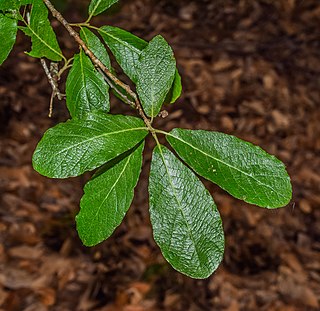
Aralia, or spikenard, is a genus of the family Araliaceae, consisting of 68 accepted species of deciduous or evergreen trees, shrubs, and rhizomatous herbaceous perennials. The genus is native to Asia and the Americas, with most species occurring in mountain woodlands. Aralia plants vary in size, with some herbaceous species only reaching 50 centimetres (20 in) tall, while some are trees growing to 20 metres (66 ft) tall.

Strobilanthes is a genus of about 350 species of flowering plants in the family Acanthaceae, mostly native to tropical Asia and Madagascar, but with a few species extending north into temperate regions of Asia. Many species are cultivated for their two-lipped, hooded flowers in shades of blue, pink, white and purple. Most are frost-tender and require protection in frost-prone areas.

Aralia cordata is an upright herbaceous perennial plant growing up to 2 to 3 metres in height, native to Japan, Korea and eastern China. Its common names include spikenard, herbal aralia, udo, Japanese spikenard, and mountain asparagus. It is commonly found on the slopes of wooded embankments. Aralia cordata is a species of Aralia in the family Araliaceae.
Aralia hypoglauca is a species of flowering plant in the family Araliaceae. It has been treated as the only species Hunaniopanax hypoglaucus of the genus Hunanioglaucus.
Quercus asymmetrica is an oak tree species in the beech family Fagaceae. It is found in China and northern Vietnam. It is placed in subgenus Cerris, section Cyclobalanopsis.

Quercus pyrenaica, commonly known as Pyrenean oak, is a tree native to southwestern Europe and northwestern North Africa. Despite its common name, it is rarely found in the Pyrenees Mountains and is more abundant in northern Portugal and north and northwestern Spain.
Quercus ungeri is a species of flowering plant in the family Fagaceae, native to north-west Iran. It was first described by Theodor Kotschy in 1858. It is placed in Quercus section Cerris.
Quercus argyrotricha is a rare Chinese species of trees in the beech family. It has been found only in Guizhou Province in southern China.
Quercus kouangsiensis is an uncommon Asian species of trees in the beech family Fagaceae. It has been found only in southern China, in the Provinces of Guangdong, Guangxi, Hunan, and Yunnan. It is placed in subgenus Cerris, section Cyclobalanopsis.
Quercus hypargyrea is an Asian species of tree in the beech family Fagaceae. It is native to south-central and southeast China, in particular the provinces of Anhui, Fujian, Guangxi, Hubei, Hunan, Jiangxi, Shaanxi, and Sichuan. It has incorrectly been known as Quercus multinervis, which is properly the name of a fossil species. It is placed in subgenus Cerris, section Cyclobalanopsis.
Quercus ningangensis is an Asian species of trees in the beech family Fagaceae. It is native to southern China. It is placed in subgenus Cerris, section Cyclobalanopsis.
Quercus stewardiana is a species of tree in the beech family Fagaceae. It is widespread across much of China. It is placed in subgenus Cerris, section Cyclobalanopsis.
Quercus xanthotricha is an Asian species of tree in the beech family Fagaceae. It has been found in northern Indochina and in southern China (Yunnan). It is placed in subgenus Cerris, section Cyclobalanopsis.
Quercus petelotii is the accepted name of an endemic oak tree species in the beech family Fagaceae; there are no known sub-species. It is placed in subgenus Cerris, section Cyclobalanopsis.
Quercus arbutifolia, synonym Quercus obovatifolia, is a species of oak in the beech family Fagaceae, native to southeast China and Vietnam. It is placed in Quercus sect. Cyclobalanopsis, the ring-cupped oaks. There are no known subspecies.
Quercus subsericea is a tree species in the beech family Fagaceae. There are no known subspecies. It is placed in subgenus Cerris, section Cyclobalanopsis.
Quercus setulosa is the accepted name of an oak species in genus Quercus of the family Fagaceae. It is now placed in section Ilex of subgenus Cerris.

Quercus sideroxyla, called the Santa Rosa oak and encino colorado, is a species of oak native to northern and southwestern Mexico. Used for charcoal production, it prefers to grow at elevations from 1,800 to 2,700 metres. It is placed in section Lobatae.
Heptapleurum heptaphyllum is a species of flowering plant in the family Rubiaceae, native to southern China, Indo-China and Japan. It was first described by Carl Linnaeus in 1771 as Vitis heptaphylla.
Alstonia sebusii, synonym Alstonia henryi, is a species of flowering plant in the family Apocynaceae, native to the region of Assam, south-central China, the east Himalayas and Myanmar. It was first described in 1871 as Blaberopus sebusii.





